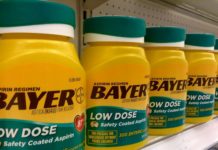
Stevens-Johnson syndrome (SJS) and Toxic epidermal necrolysis (TEN) are life threatening reactions to medications that can occur. These reactions are characterized by widespread skin necrosis resulting in skin detachment. While these reactions can occur after initial drug intake, they can also happen following many years of taking the medication. The tell tale signs of SJS and TEN are a purple colored rash that appears in the genital, ocular and orbital areas on the body.
Stevens-Johnson Syndrome and TEN differ in the severity of the disease. SJS results in less than 10% of skin detachment where TENS results greater than 30% of the skin detachment. (see reference 1 below) The danger in this syndrome lies in the complications that follow the attack. The destruction of of our first line of defense our skin, leaves patients susceptible and vulnerable to infection.
As pharmacists we are often shown many rashes by our patients. As accessible health care providers it is important that we are knowledgeable about this deadly rash. It may appear darker purple on people with more melanin in the skin. It is important that we ask the presenting patients further questions and warn patients to seek medical attention if the situations warrants this.
Personal Story
My first encounter with SJS occurred during my studies in pharmacy school. My class at school was shown images of SJS and TEN. Following class, my mother called and reported a rash on her body. As she described the purplish rash on her genital area and on legs and thighs I was frightened. I advised her to seek medical help at a hospital where she was diagnosed with SJS. She was reacting to Zocor, a drug which she had been taking for several years.
My second experience occurred 4 years later when my mother was being cared for post-op brain surgery at a medical facility in Durham NC. During my visit, I noticed a purplish rash on her ears. Upon quick examination I found the rash was also present in her genital area. At this point I was a licensed pharmacist and so I examined what drugs she had been given. In spite of her reported history of SJS with Zocor, my mother had been given Zocor. I immediately reported this to a reluctant physician who later treated her for SJS.
My final experience with SJS occurred while at work. An African American woman sought consultation for a dark purple rash on her hands. None of her medication was new. I asked her to examine her body and look for signs of this rash in other areas. She returned shortly after this from bathroom after she found the rash in her genital area. I advised her to seek immediate further medical attention. While I do not know the outcome of her hospital visit, I believe further medical examination with warranted.
Lessons learned
- Ask as many questions as possible
- SJS or TENS can occur at any point of therapy
- Is the rash wide spread?
- What areas?
- What color?
- Intervene when necessary
Reference:
- W. A. High, March 12, 2019. Sevens-Johnson syndrome and toxic epidermal necrolysis: Pathogenisis, clinical manifestations, and diagnosis. uptodate.com. March 2019.






